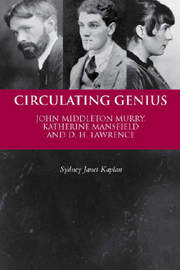Book contents
- Frontmatter
- Contents
- Acknowledgements
- Abbreviations
- Introduction
- 1 ‘My Blundering Way of Learning’: Murry's Still Life
- 2 Still Life and Women in Love
- 3 From Still Life to ‘Bliss’
- 4 ‘A Furious Bliss’
- 5 ‘With Cannonballs for Eyes’
- 6 ‘The Coming Man and Woman’
- 7 The Things We Are
- 8 Circulating Mansfield
- 9 Circulating Lawrence
- 10 Circulating Murry
- Bibliography
- Index
5 - ‘With Cannonballs for Eyes’
Published online by Cambridge University Press: 12 September 2012
- Frontmatter
- Contents
- Acknowledgements
- Abbreviations
- Introduction
- 1 ‘My Blundering Way of Learning’: Murry's Still Life
- 2 Still Life and Women in Love
- 3 From Still Life to ‘Bliss’
- 4 ‘A Furious Bliss’
- 5 ‘With Cannonballs for Eyes’
- 6 ‘The Coming Man and Woman’
- 7 The Things We Are
- 8 Circulating Mansfield
- 9 Circulating Lawrence
- 10 Circulating Murry
- Bibliography
- Index
Summary
A happy ending to their epistolary story remained only in the realm of the imagination for Murry and Mansfield. The linear movement of a teleological narrative suggests some form of apocalyptic transformation: the timeless ‘bliss’ of The Heron. But Mansfield's return to London on 11 April 1918 is only the beginning of another story, a return to a cyclical rather than a teleological pattern. It is a return to dissatisfaction with Murry, to Bloomsbury social politics, to the competition and opportunism of the literary life, a narrative pattern far more in keeping with the flavour of modernist disjunction, disillusionment and deconstruction. This is not to say that the teleological Romance is completely destroyed, however. It continues to haunt their relations with each other. But for Mansfield now, the only certain resolution of it is her dying. And for Murry, as we shall see, it will remain both a motivating force and an explanatory tool for his life's trajectory, in which a variety of utopian plans and schemes continue to collide with cyclical encounters with what he called ‘Necessity’. These collisions exemplify his enduring propensity both to repeat and to escape from the defining moments of his life.
Instead of the longed-for ‘Heron’, Mansfield had returned to live with Murry in his dreary rooms on the Redcliffe Road. They were finally married on 3 May 1918 with Brett and J. D. Fergusson as their witnesses. In her diary, Virginia Woolf describes Mansfield, only six days afterwards, as ‘marmoreal, as usual, just married to Murry, & liking to pretend it a matter of convenience. She looked ghastly ill’ (DVW 1: 150).
- Type
- Chapter
- Information
- Circulating GeniusJohn Middleton Murry Katherine Mansfield and D. H. Lawrence, pp. 96 - 117Publisher: Edinburgh University PressPrint publication year: 2010



